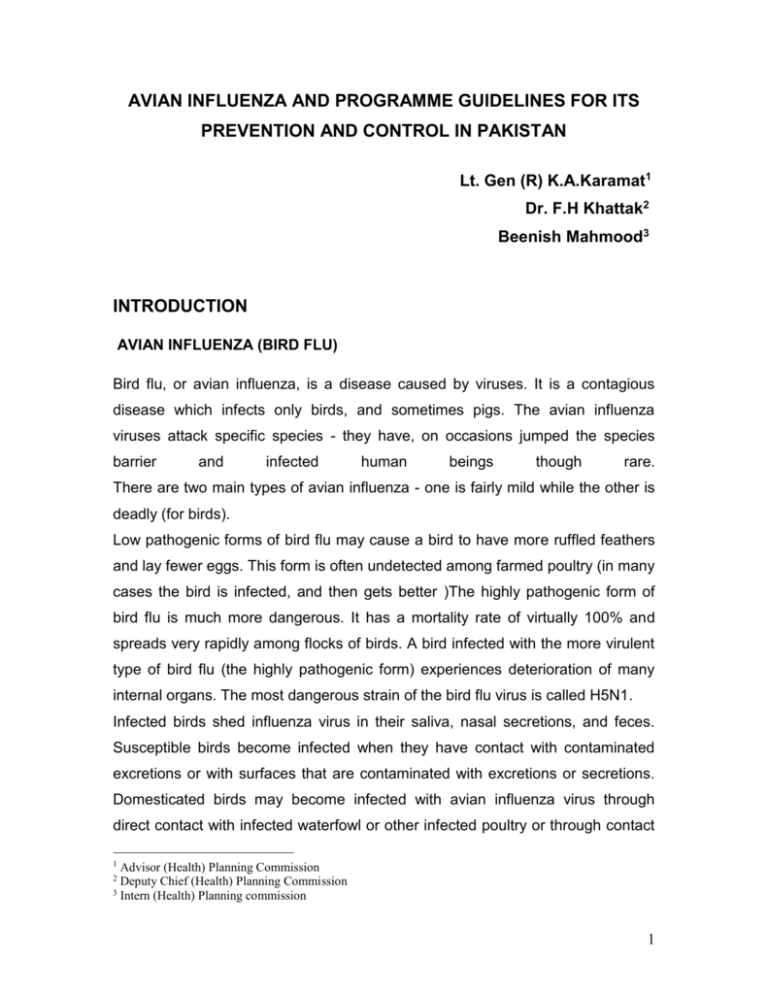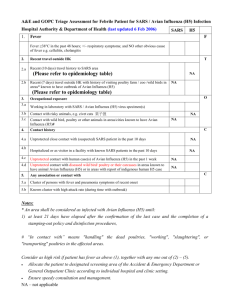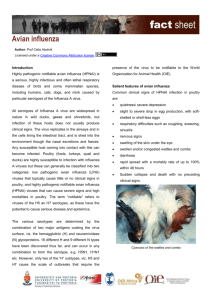Avian influenza A (H5N1) viruses usually affect wild birds but now
advertisement

AVIAN INFLUENZA AND PROGRAMME GUIDELINES FOR ITS PREVENTION AND CONTROL IN PAKISTAN Lt. Gen (R) K.A.Karamat1 Dr. F.H Khattak2 Beenish Mahmood3 INTRODUCTION AVIAN INFLUENZA (BIRD FLU) Bird flu, or avian influenza, is a disease caused by viruses. It is a contagious disease which infects only birds, and sometimes pigs. The avian influenza viruses attack specific species - they have, on occasions jumped the species barrier and infected human beings though rare. There are two main types of avian influenza - one is fairly mild while the other is deadly (for birds). Low pathogenic forms of bird flu may cause a bird to have more ruffled feathers and lay fewer eggs. This form is often undetected among farmed poultry (in many cases the bird is infected, and then gets better )The highly pathogenic form of bird flu is much more dangerous. It has a mortality rate of virtually 100% and spreads very rapidly among flocks of birds. A bird infected with the more virulent type of bird flu (the highly pathogenic form) experiences deterioration of many internal organs. The most dangerous strain of the bird flu virus is called H5N1. Infected birds shed influenza virus in their saliva, nasal secretions, and feces. Susceptible birds become infected when they have contact with contaminated excretions or with surfaces that are contaminated with excretions or secretions. Domesticated birds may become infected with avian influenza virus through direct contact with infected waterfowl or other infected poultry or through contact 1 Advisor (Health) Planning Commission Deputy Chief (Health) Planning Commission 3 Intern (Health) Planning commission 2 1 with surfaces (such as dirt or cages) or materials (such as water or feed) that have been contaminated with the virus. SCIENTIFIC DIMENSION OF AVIAN INFLUENZA Avian Influenza (AI) is highly contagious viral infection; primarily of the avian species. The casual virus mainly affects gastrointestinal, respiratory, reproductive and/or nervous systems of the affected birds. In case of systematic infection, the virus is capable of causing sudden death resulting in high mortality and egg production losses in the affected flocks. Of the known 16 subtypes of AI virus, H5 and H7 are high-risk strains and are known to cause severe infection in poultry and on some occasions in humans too. The world animal Health Organization (OIE) has declared H5 and H7 infection as notifiable AI, making it mandatory for all the countries to notify the disease to OIE. Avian influenza does not usually infect humans, however, once transmitted; the infection may lead to the influenza-like symptoms, viral pneumonia, and other severe life threatening complications. Beginning in 2003, incidence of H5N1 infection in humans has increased mostly in the Asian countries. So far, all the genes identified from the recovered viruses are of avian origin, indicating that the virus has not yet acquired human genes. The acquisition of Human gene is known to increase the likelihood that a virus of avian origin can be readily transmitted from one human to another, resulting into human pandemic. However, molecular epidemiology data indicates that currently circulating strains of H5N1 viruses are more capable of causing diseases (pathogenic) in animals than were the earlier H5N1 viruses. The virus continues to evolve and may adopt so that other mammals (including human) may be susceptible to infection as well. There is a hypothesis that explains why wild birds die of avian flu at winter nesting areas. If the virus has already emerged in the environment, it persists there for a long time. Its pathogenic qualities become more pronounced during winter, when wilds birds have a hard time (in Europe and Southern Russia). 2 Stress, low temperatures, and lack of food reduce their immunity, and they are more likely to catch different diseases, including avian flu.[1] HUMAN INFECTION WITH AVIAN INFLUENZA VIRUSES There are different subtypes of type A influenza viruses. These subtypes differ because of changes in certain proteins on the surface of the influenza A virus (hemagglutinin [HA] and neuraminidase [NA] proteins). There are 16 known HA subtypes and 9 known NA subtypes of influenza A viruses. Many different combinations of HA and NA proteins are possible. Each combination represents a different subtype. All known subtypes of influenza A viruses can be found in birds. [2] Usually, “avian influenza virus” refers to influenza A viruses found chiefly in birds, but infections with these viruses can occur in humans. The risk from avian influenza is generally low to most people, because the viruses do not usually infect humans. However, confirmed cases of human infection from several subtypes of avian influenza infection have been reported since 1997. Most cases of avian influenza infection in humans have resulted from direct or close contact with infected poultry (e.g., domesticated chicken, ducks, and turkeys) or surfaces contaminated with secretions and excretions from infected birds. The spread of avian influenza viruses from an ill person to another person has been reported very rarely, and transmission has not been observed to continue beyond one person. During an outbreak of avian influenza among poultry, there is a possible risk to people who have direct or close contact with infected birds or with surfaces that have been contaminated with secretions and excretions from infected birds Studies done in laboratories suggest that some of the prescription medicines approved in the United States for human influenza viruses should work in treating avian influenza infection in humans. However, influenza viruses can become resistant to these drugs, so these medications may not always work. Additional studies are needed to demonstrate the effectiveness of these medicines. 3 STATUS OF HUMAN CASES AND DEATHS IN THE REGIONAL COUNTRIES The following table depicts the picture of human cases and deaths in the 14 countries of the globe: TABLE: 1 Sr No. Country 2003 1. Azerbaijan C 0 D 0 C 0 D 0 C 0 D 0 C 8 D 5 C 0 D 0 C 0 D 0 C 8 D 5 2. Cambodia 0 0 0 0 4 4 2 2 1 1 0 0 7 7 3. China 1 1 0 0 8 5 13 8 5 3 0 0 27 17 4. Djibouti 0 0 0 0 0 0 1 0 0 0 0 0 1 0 5. Egypt 0 0 0 0 0 0 18 10 25 9 0 0 43 19 6. Indonesia 0 0 0 0 20 13 55 45 42 37 10 8 127 103 7. Iraq 0 0 0 0 0 0 3 2 0 0 0 0 3 2 8. Lao PDR 0 0 0 0 0 0 0 0 2 2 0 0 2 2 9. Nigeria 0 0 0 0 0 0 0 0 1 1 0 0 1 0 10. Thailand 0 0 17 12 5 2 3 3 0 0 0 0 25 17 11 Turkey 0 0 0 0 0 0 12 4 0 0 0 0 12 4 12. Viet Nam 3 3 29 20 61 19 0 0 8 5 2 2 103 49 13. Pakistan 0 0 0 0 0 0 0 0 1 1 0 0 1 1 14. Mayammar 0 0 0 0 0 0 0 0 1 0 0 0 1 0 4 4 46 32 98 43 115 79 86 59 12 10 361 227 TOTAL 2004 2005 2006 2007 2008 Total C: Case D: Deaths SOURCE: World Health Organization DATA ANALYSIS The dangerous H5N1 strain has been circulating for five years. This is an unprecedented long period, but the strain is still as active as before. It was revealed in domestic geese in China in 1996 for the first time. A year later, it killed poultry at farms and wholesale markets of Hong Kong. Since 2003, people started dying from it. All in all, 361 people have been infected with this strain in 14 countries (Azerbaijan, Cambodia, China, Djibouti, Egypt, Indonesia, Iraq, 4 Laos, Myanmar, Nigeria, Pakistan, Thailand, Turkey and Vietnam), with 227 deaths. The data analysis shows a very alarming situation of the cases and deaths in the above 14 countries. A quantum jump from 04 cases and deaths, in 2003 to 86 cases and 59 deaths in 2007 is alarming. The most responsible factors in 2003 may be that the majority of cases were not diagnosed and registered because of the unawareness and due to lack of advocacy and proper information system. Out of 46 Cases in 2004; there were 32 deaths (69%), while deaths in 2005 are 44% of the total cases registered/diagnosed. However cases registered during 2005 are 113% higher than 2004.Maximum cases registered were 115 in 2006 with 79 deaths (Deaths were 69% of the cases diagnosed). There is a gradual decline of the cases and deaths in 2007, but it is still higher than the base year of 2003 and 2004.Total cases in the five years period (2003-07) are 349, and deaths are 217 (62%). The data analysis suggests having more preventive and curative measures of avian influenza. Despite the fact new technology and vaccines have emerged, still the spread of avian influenza is faster than the cure rate. This trend also embarks for more research to discover the cost effective and efficient ways and means for prevention, control and treatment of influenza. The analysis also shows the highest cases and deaths registered in Indonesia which is 127 and 103 respectively, followed by Vietnam which is 103 and 49, respectively. The ecology and environment of such countries needs a special attention to be studied through research for identification of the factors responsible for the high cases and deaths in these countries. Such ecological and environmental factors shall be studied and controlled before it becomes endemic in the other countries. 5 SITUATION ANALYSIS OF AVIAN INFLUENZA IN PAKISATN The first case of human infection with H5N1 avian influenza was confirmed in Nov. 2007 in Pakistan. Laboratory tests conducted by the WHO H5 Reference Laboratory in Cairo, (Egypt) and WHO Collaborating Center for Reference and Research on Influenza, (London, United Kingdom) have confirmed the presence of avian influenza virus strain A(H5N1) in samples collected from one case in an affected family. The H5N1 positive case was a 25 year old male from the Peshawar area who developed febrile respiratory illness on 21 November, 2007 and was hospitalized on 23 November, but died on 28 November 2007. Additional laboratory analysis, including gene sequencing, was ongoing till compiling the data for this article. On the request of the Government, a WHO team travelled to Pakistan for participation with national authorities in the ongoing investigations of several suspected cases of human H5N1 infections. Following are the findings of the team report: I. The preliminary risk assessment found no evidence of sustained or community human to human transmission. II. All identified close contacts including the other members of the affected family and involved health care workers remain asymptomatic and have been removed from close medical observation. III. The Ministry of Health in Pakistan has taken timely steps to investigate and contain this event including case isolation, contact tracing and monitoring, detailed epidemiological investigations, increasing the availability of personal protective equipment, dedicating hospital facilities for any new suspected cases, and other infection control measures. In addition, agricultural authorities, including the Ministry of Food, Agriculture and Livestock and FAO, have activated technical partners for the effective control of this limited outbreak. 6 IV. Pakistani authorities confirmed another fresh outbreak of the H5N1 strain of bird flu at a poultry farm on the outskirts of Karachi in 2007. V. Authorities have found several outbreaks of the virus in poultry and birds in North West Frontier Province and the capital, Islamabad, since it was first detected in the country in early 2006. Samples taken from it were tested and found positive for H5N1."Some 500 to 600 birds died of the virus and the remaining 5,500 chickens were culled now.” Tests were also being done on samples taken from poultry farms in Punjab province but no outbreak had been confirmed. Following are the major steps to be taken for the control of Avian influenza in future A. SURVEILLANCE OF HUMAN CASES: I. Immediate dispatch of Joint MoH-WHO Rapid Response teams to the affected districts. II. Strengthening of Lab capacity at NIH-Islamabad for viral culture, sub-typing, serology and molecular (PCR) testing III. Existing Polio Surveillance System activated for case finding, sample collection and transportation to the virology Laborotary, NIH-Islamabad. IV. Hospital-based surveillance of severe pneumonia at 20 tertiary hospitals across Pakistan launched V. Provinces/AJK/NAs directed to attach public health specialists with rapid Response Teams for joint response to the outbreaks amongst farmers and cullers. 7 VI. Districts Monitoring and response Committees under DCOs to be constituted. VII. Federal Monitoring Cell at NIH is monitoring the situtaion 24 hours. VIII. Viral transport media has been supplied to the provincial Health Departments for the collection and transportation of the samples from any suspected patients. IX. Antiviral medicine, Oseltamivir (Tamiflu and other) has been purchased from national manufactureres and 6000 doses has been stockpiled (5000 adults and 1000 children) X. Establishment of Joint Steering Committees at Federal Level by the Government of Pakistan under the chairmanship of Federal Minister for health with federal Minister for Food, Agriculture and Livestock as Co- Chairman. B. STRATEGIES: Public health Surveillance of human infections, with epidemiologic and laboratory investigations Stockpiling and logistics Emergency responses Strengthened case management Infection control Public communication Integrated command and coordination Animal health Active surveillance Culling infected flocks with compensation Controlling movement of poultry 8 Improving biosecurity Biosecurity Zoning and compartmentalization PREVENTION AND CONTROL OF AVIAN INFLUENZA IN PAKISTAN Government of Pakistan has taken prompt action to prevent and control the virus in the country by launching a Programme at the national level. The Programme addresses all epidemiological phases of expected influenza outbreak i.e. PrePandemic, Pandemic and Post-pandemic for efficient, timely and comprehensive response to contain outbreak, prevent possible losses of life and social disruption through mobilizing all national and provincial line departments, NGOs and Civil society. It includes persistent monitoring of information, assessment of impact, assessment of resource needs (e.g. morbidity, mortality, workplace absenteeism, region affected, risk groups affected, health-care workers and other essential worker’s availability, health care-supplies, bed occupancy/availability, admission pressures, use of alternative health facilities, mortuary capacity). The specific objectives of the program are;[3] I. Reduction of morbidity and mortality due to human cases of Avian influenza and/or human influenza pandemic by monitoring the spread of influenza-A/ H5N1 and pandemic strain viruses in humans. II. To ensure a prompt, coordinated and organized emergency response to influenza pandemic by all stakeholders III. To ensure availability of efficient and adequate clinical services and antiviral medicines by the public and private sectors health care facilities and providers during an influenza pandemic. IV. To develop and evolve strategies for selection, usage/distribution and monitoring of influenza vaccines(s). V. To develop and evolve strategies based on non-pharmaceutical public health actions for the containment of the flu pandemic VI. To create awareness about modes of transmission and preventive measures. 9 Main activities and the Budget of the programme is given in the following table: TABLE: II Main Activities and Budget of the Programme Sr. No. 1 2 3 4 5 6 7 8 9 10 11 12 Activities Emergency Response Clinical Health Services Antiviral Medicines Containment and Quarantine Communication Establishment Transport Lab Supplies Civil Work Office Equipment etc. Personal protective Equipment Center for Disease Control (CDC) Atlanta as technical assistance under Lab Base Influenza Like Illness (ILI) Surveillance project. Proposed Cost (Rs. Million) 2.400 8.900 161.040 6.120 5.000 34.989 2.700 5.000 37.000 2.902 50.000 5.000 321.051 13 Sub-Total Contingencies @ 3% of sub-total 9.632 330.683 Grand Total Source: PC-I of Prevention and Control of Avian Influenza, Health Division (N.I.H.) Islamabad 2006 2. The above program activities are under implementation at the total cost of project Rs. 330.683 million. An amount of Rs. 100.00 million has been provided in the PSDP 2007-08.Following activities will be undertaken under the Programme.[4] 1: Emergency Response -2: Clinical Health Service 3: Antiviral Medicine 4: Containment and Quarantine Activities 5: Health education and Communication 10 6: Pre testing the Emergency Response CONCLUSION AND RECOMMENDATION: 1. The outbreak in poultry weakens and jeopardizes food security. In the past H9N3 and H9N2 have caused significant poultry losses. At preset there is approximately Rs.8.00 billion investments in poultry business in Pakistan according to Pakistan Poultry Association. With the implementation of project the losses will be reduced to their minimum level saving investment of people and increased production of better quality meat. This virus infects human beings too and can make a number of people (attached with this business) ill having adverse impact on their earning and in such case large amount of money will be spent on medication. 2. High distortion of the poultry decreases the supply, depresses the prices down and on other hard prices of meat soar up and go beyond the purchasing power of a middle income family. 3. Community mobilization for awareness shall be the important factor of the Programme. 4. Reference Laboratories shall be established at the provincial levels. The required medicines, will be made available and awareness programme to be launched at the gross root levels. 5. LHWS can be effective medium for awareness, and developing preventive measure in cooking and using of the poultry and poultry product. 11 REFERENCES 1. http://en.rian.ru/analysis/20080206/98571615.html 2. http://www.cdc.gov/flu/avian/gen-info/facts.html 3. P.C 1 of National Programme of Prevention Control of Avian Influenza (bird flu) in Pakistan- 2006. 4. Public Sector Development Programme (PSDP 2007-08) Planning Commission of Pakistan, June 2007. 5. Tool Kit for Early detection and control of Human Cases of avian Influenza, WHO-MOH, Pakistan 2006. 6. WHO Manual on Animal Influenza Diagnosis and Surveillance 7. WHO/CDS/CSR/NCS/2002.5 Rev. 1 http://www.who.int/csr/resourses/publication/influenza/whocdsrncs2 0025rev.pdf 8. WHO Guidelines for the collection of human specimen for laboratory diagnosis of avian influenza infection.12 January 2005 http://www.who.int/csr/disease/avianinfluenza/guidelines/humanspecimens/en/print.html 9. http://www.who.int/csr/disease/avianinfluenza/guidelines/transport/en/ 12






